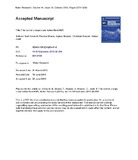JavaScript is disabled for your browser. Some features of this site may not work without it.
| dc.contributor.author | Verrecht, Bart | |
| dc.contributor.author | Maere, Thomas | |
| dc.contributor.author | Ingmar, Nopens | |
| dc.contributor.author | Brepols, Christoph | |
| dc.contributor.author | Judd, Simon J. | |
| dc.date.accessioned | 2011-01-27T11:58:34Z | |
| dc.date.available | 2011-01-27T11:58:34Z | |
| dc.date.issued | 2010-10 | |
| dc.identifier.citation | Bart Verrecht, Thomas Maere, Ingmar Nopens, Christoph Brepols and Simon Judd, The cost of a large-scale hollow fibre MBR, Water Research, Volume 44, Issue 18, October 2010, Pages 5274-5283 | en_UK |
| dc.identifier.issn | 0043-1354 | |
| dc.identifier.uri | http://dx.doi.org/10.1016/j.watres.2010.06.054 | |
| dc.identifier.uri | http://dspace.lib.cranfield.ac.uk/handle/1826/4774 | |
| dc.description.abstract | A cost sensitivity analysis was carried out for a full-scale hollow fibre membrane bioreactor to quantify the effect of design choices and operational parameters on cost. Different options were subjected to a long term dynamic influent profile and evaluated using ASM1 for effluent quality, aeration requirements and sludge production. The results were used to calculate a net present value (NPV), incorporating both capital expenditure (capex), based on costs obtained from equipment manufacturers and full-scale plants, and operating expenditure (opex), accounting for energy demand, sludge production and chemical cleaning costs. Results show that the amount of contingency built in to cope with changes in feedwater flow has a large impact on NPV. Deviation from a constant daily flow increases NPV as mean plant utilisation decreases. Conversely, adding a buffer tank reduces NPV, since less membrane surface is required when average plant utilisation increases. Membrane cost and lifetime is decisive in determining NPV: an increased membrane replacement interval from 5 to 10 years reduces NPV by 19%. Operation at higher SRT increases the NPV, since the reduced costs for sludge treatment are offset by correspondingly higher aeration costs at higher MLSS levels, though the analysis is very sensitive to sludge treatment costs. A higher sustainable flux demands greater membrane aeration, but the subsequent opex increase is offset by the reduced membrane area and the corresponding lower capex. | en_UK |
| dc.language.iso | en | en_UK |
| dc.publisher | Elsevier | en_UK |
| dc.subject | Membrane bioreactor | en_UK |
| dc.subject | Cost sensitivity | en_UK |
| dc.subject | Life cycle | en_UK |
| dc.subject | Biokinetics | en_UK |
| dc.subject | Aeration | en_UK |
| dc.title | The cost of a large-scale hollow fibre MBR | en_UK |
| dc.type | Article | en_UK |
Files in this item
This item appears in the following Collection(s)
-
Staff publications (SAS) [907]
